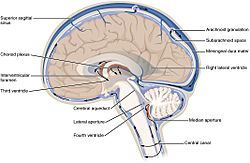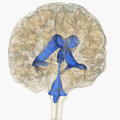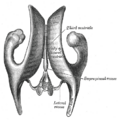Ventricles of brain facts for kids
| Brain: Cerebral ventricles | ||
|---|---|---|
Quick facts for kids
|
||
| The ventricular system accounts for the production and circulation of cerebrospinal fluid. | ||
| Latin | Ventriculi cerebri | |
| NeuroNames | ancil-192 | |
| MeSH | Cerebral+Ventricles | |
Your brain has special hollow spaces inside it called ventricles. These spaces are filled with a clear liquid known as cerebrospinal fluid (CSF). There are four main ventricles in a human brain.
Together, these spaces form the ventricular system. This system is connected to the central canal of your spinal cord. The inside of the ventricles has a special lining. This lining helps to make the cerebrospinal fluid. All the ventricles are connected, allowing the fluid to move freely.
Contents
What Are Brain Ventricles?
The ventricles are like small, connected rooms deep inside your brain. They are not empty, but filled with a very important fluid. Think of them as a network of tunnels. This network helps your brain stay healthy and protected.
There are four main ventricles:
- Two lateral ventricles, one in each half of your brain.
- The third ventricle, located in the middle of your brain.
- The fourth ventricle, found near the brainstem and cerebellum.
These ventricles are all linked together. This allows the special fluid inside them to flow from one area to another.
What is Cerebrospinal Fluid (CSF)?
Cerebrospinal fluid, or CSF, is a clear, watery liquid. It is very important for your brain and spinal cord. CSF has several key jobs:
- Protection: It acts like a cushion for your brain. If you bump your head, the CSF helps to absorb the shock. This protects your brain from injury.
- Nutrients: CSF carries important nutrients to your brain cells. These nutrients help your brain work properly.
- Waste Removal: It also helps to remove waste products from your brain. This keeps your brain clean and healthy.
The CSF is made by special cells that line the ventricles. These cells are part of something called the choroid plexus.
How Does the Ventricular System Work?
The ventricular system is always busy. It produces and circulates cerebrospinal fluid. Here is how it generally works:
- Production: The choroid plexus, found in each ventricle, constantly makes new CSF.
- Circulation: The CSF flows from the lateral ventricles into the third ventricle. From there, it moves into the fourth ventricle.
- Absorption: After circulating around the brain and spinal cord, the CSF is absorbed back into your bloodstream. This happens through special structures called arachnoid villi.
This continuous flow ensures that your brain always has fresh, clean fluid. It also makes sure waste is removed efficiently.
See also
 In Spanish: Ventrículo cerebral para niños
In Spanish: Ventrículo cerebral para niños
Images for kids











